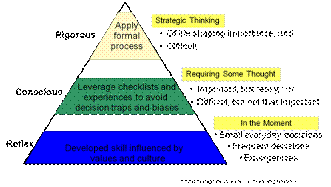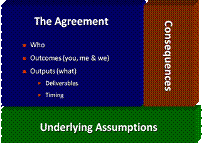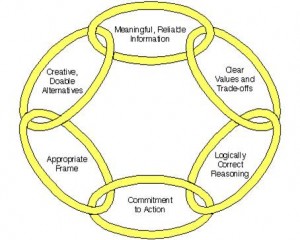Effective and efficient decision making is at the heart of successful project teams, so it’s critical for project leaders to be aware of how decision making processes are REALLY operating within the team. Breaking decisions down into three distinct levels allows the PM to better manage the mission critical choices while providing a framework to align the hundreds of task specific decisions made by team members on a daily basis. The Responsibility & Accountability Matrix (RAM) is a great place to document the conversations regarding decision authority, processes and tools that every member is expected to be aware of.
be aware of how decision making processes are REALLY operating within the team. Breaking decisions down into three distinct levels allows the PM to better manage the mission critical choices while providing a framework to align the hundreds of task specific decisions made by team members on a daily basis. The Responsibility & Accountability Matrix (RAM) is a great place to document the conversations regarding decision authority, processes and tools that every member is expected to be aware of.
Reflex decisions are the common ones that are driven by the values and priorities of the company/department. Since these are often delegated to others in the organization it’s essential to ensure the project team has a shared understanding of the driving forces behind these decisions. Establishing “Team Agreements” is a strategy for managing these decisions to maximize efficiency, reduce bottle-necks, build trust and reinforce desired behaviors into everyday decisions.
driven by the values and priorities of the company/department. Since these are often delegated to others in the organization it’s essential to ensure the project team has a shared understanding of the driving forces behind these decisions. Establishing “Team Agreements” is a strategy for managing these decisions to maximize efficiency, reduce bottle-necks, build trust and reinforce desired behaviors into everyday decisions.
Conscious decisions are at the heart of team execution. Strategic direction gets translated into specific actions pertaining to WHAT and HOW choices that will have profound impact on the project team’s results. Collaborative processes ensure that diverse interests and perspectives are shared to make the “best” decision that the core team members are willing to actively support.
Rigorous deci sions are the mission critical decisions that define the direction of the project’s activity. Major investments of time and money are at stake with these, so it’s important to make sure the right people are taking an objective look at decision criteria and sharing open, honest perspectives on the risks and impact these decisions will have on the project and company. Document the thinking and data that went into making the decision and revisit these periodically to update/validate the assumptions, data and risk assessments for stakeholder review.
sions are the mission critical decisions that define the direction of the project’s activity. Major investments of time and money are at stake with these, so it’s important to make sure the right people are taking an objective look at decision criteria and sharing open, honest perspectives on the risks and impact these decisions will have on the project and company. Document the thinking and data that went into making the decision and revisit these periodically to update/validate the assumptions, data and risk assessments for stakeholder review.

